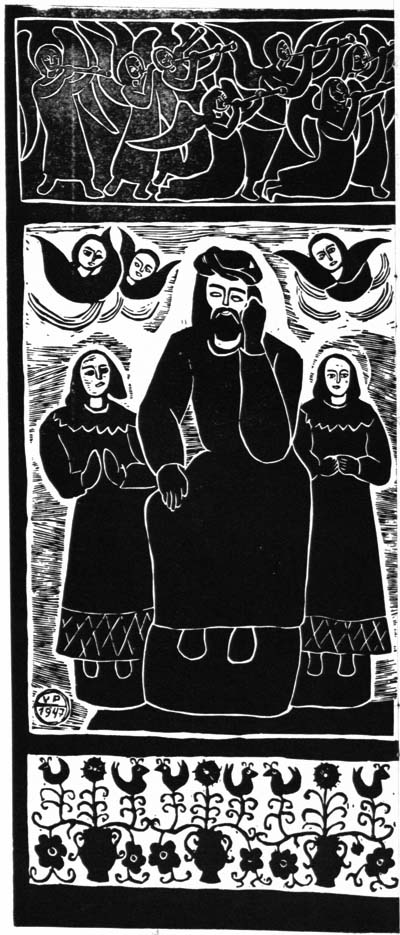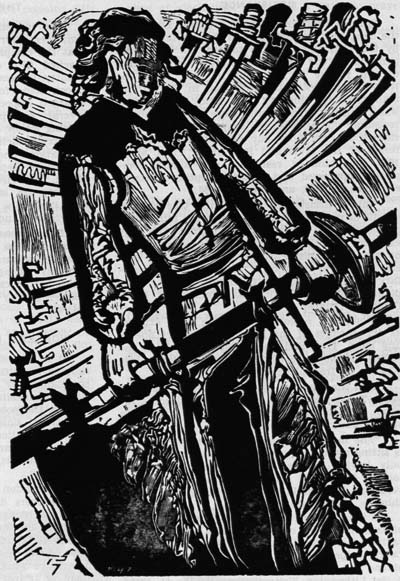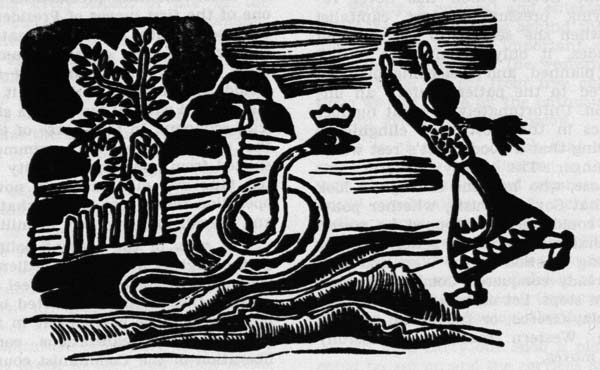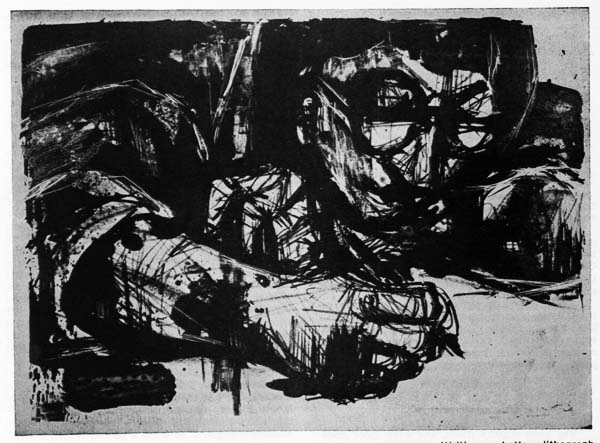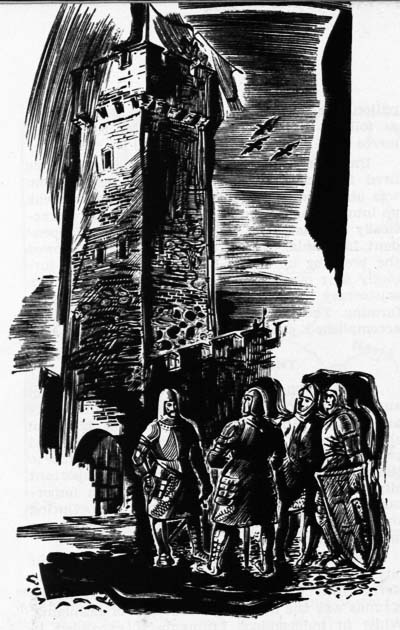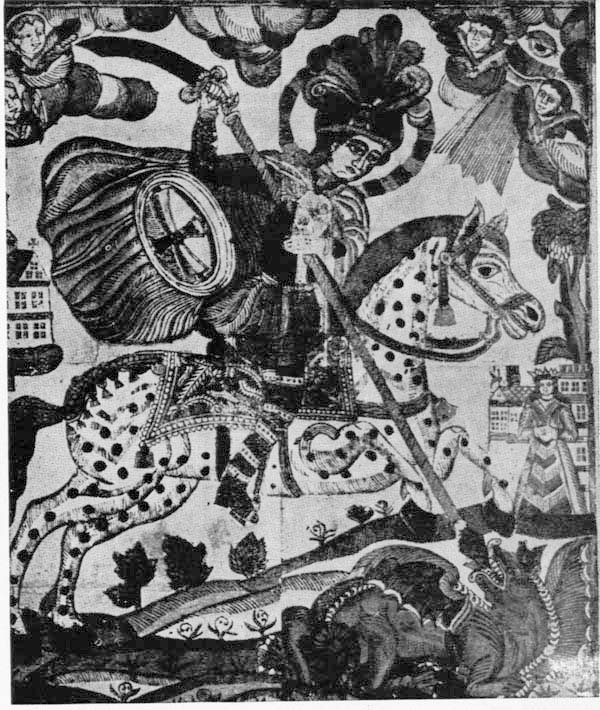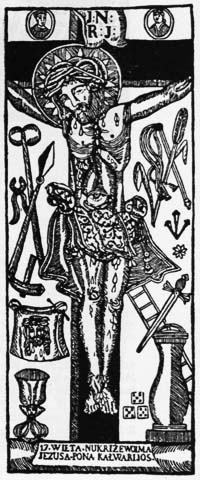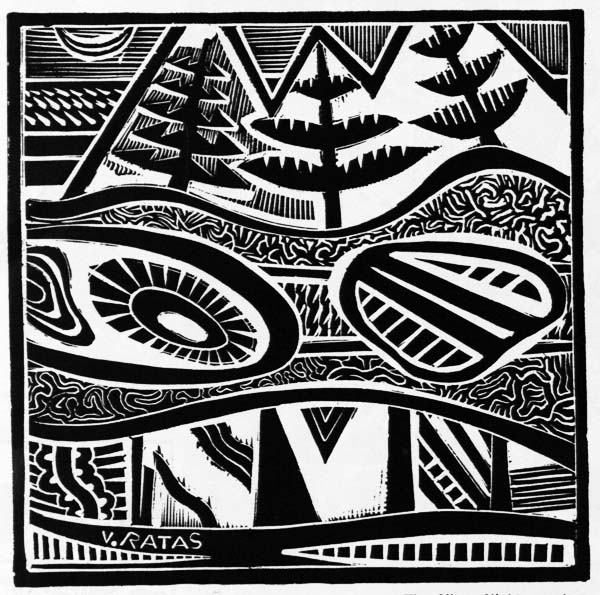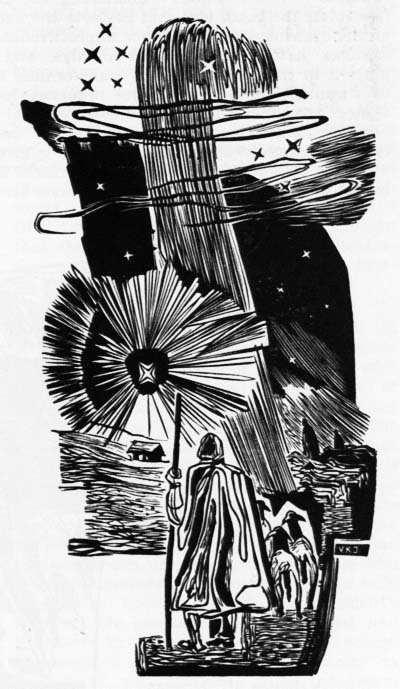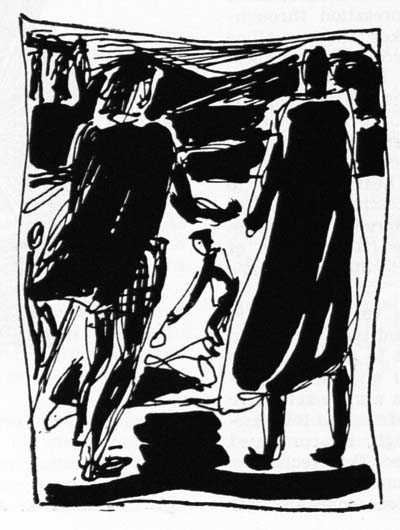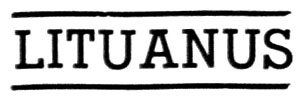
Editor of this issue: L. Sabaliūnas
 |
www.lituanus.org |
|
Copyright
© 1956 Lithuanian
Student Association, Inc.
No.
2(7)
- June 1956
Editor of this issue: L. Sabaliūnas |
|
The New Lithuanian Graphic Arts
PAULIUS JURKUS
PAULIUS
JURKUS, a
graduate of University of Vilnius, now is an editor of Lithuanian
newspaper "Darbininkas". He writes short stories, poetry and articles
on art and literature.
The new Lithuanian graphic arts are connected with the Art School of Kaunas (est. 1923) where the class in graphic arts was under the leadership of a now famous painter, Adomas Galdikas.
Neither the school itself nor its graduates had any connection with the Old graphic arts which spread from the University of Vilnius at the end of 18th and the beginning of the 19th century. At that time there were gifted engravers, wood-carvers, and book illustrators. (In the 17th century there was the famous copper engraver Tomas Ma-kovskis; in the beginning of the 19th century Juozas Saundersas worked as instructor of engraving in the University of Vilnius — although of English descent he worked for a long time in the Ermitage Museum, Petersburg, thru moved to Vilnius where his pupils included the noted artists Mykolas Podolinskis, Bogumilas, and Kislingas; in the middle of the 19th century an outstanding wood carver, Vincas Smokauskis, traced Lithuania's past and illustrated the writings of Ignas Krasevskis and A. Mickevicius.) They all worked in the established mood of that time and quite often fell into formalism.
This historical heritage was already foreign to the young School of Kaunas, where the faculty members were more or less modernists. The graphic arts grew from the temperate Western modernism. The leader of the studio, Professor A. Galdikas, who himself studied graphic art but turned to painting, gave his students a great d-ral of freedom, thus avoiding the pressure of the instructcr's influence in their works. After graduating, student-tried independently to develop an original style, although they often fell under the influence of tho styles of other nations or stiffened into formalism.
At this time the Art School of Kaunas with Professor A. Galdikas as the leading man showed a great interest in Lithuanian National arts. This interest had already become a tradition, and now it turned into a particular movement which affected the graphic arts and the plastic arts in general. The samples of folk art taken to other countries (exhibits took places in Stockholm, Paris, Monza, Italy) received good appraisals. In the national art were found accumulated, and as yet undlsslpated, tremendous resources of creative power and originality,
Thus there arose pi movement among Lithua-anian artists. In J932 the "Ars" group was established, in 1933, "Forma", The artists who gathered in these groups decided to revive the national arts by exploiting the profits of Western European Modern art,
Lithuanian National art has Interesting woodcuts dating back as far as the 17th century. All these works are of purely religious subject-matter, carved in wood with primitive means. They reflect some baroque influence — the models are taken from the reproductions of Western European Masters* for example, "The Coronation of the Virgin Mary" by Rubens, Durer's "Crucifixion," and a few works of Paolo Veronese and of van der Weiden). Nevertheless the interpretation of the subject remained original. The figures are carved in a strong outline, the shadowing is done by clustering the lines; as in the Middle Ages the minor figures are half the size of the major ones; nature is reduced into an ornamental symbol without perspective. The design lingers between primitivism and subi ism, though the sincere and creatively deep Lithuanian soul breaks through and spontaneously grasps the spirit of the time in clarity of form and lyric interpretation.
All this animated the new graphic arts. In the beginning some of the artists yielded to the copying of folk style completely eluding the artist's individuality. In this undertaking — to recreate the national art — a famous Russian graphic artist, Bilibin, experimented. The principle, however, is essentially wrong, because no historic art can be created or repeated, and this approach was soon rejected. From the old national engravings only the principles of form interpretation were taken. The rest was transfused through the prism of modernism, while sincerity and frankness pierced through the whole work.
Here we can not forget the fact that, in Paris, too, at this time, a great interest was directed toward primitive nations and national arts in general. Therefore the interest in Lithuanian folk art found some reflection abroad. A great number of Lithuanian artists went to study in Paris. Their return to primitivism through folk-graphic arc corresponded to the popular views of that time.
So from 1932-33 our graphic arts turned a ntw way, becoming both creative and self-dependent. They grew tremendously, monumentally decorating the books and producing separate subjective compositions. No other branch of art spread out so vividly nor gave such wonderful results as did the graphic arts. Their particular characteristic is power of expression, deep and clear grasp of the idea, primacy before form, and a tendency toward synthesis and symbolism.
For the first time in Western Europe
the youns
artists exhibited in Czechoslovakia, at the Kosic Museum, where they
received very favourable evaluations. Later they exhibited in other
European cities, then in New York.
In 1944, when Lithuania was occupied by Bolsheviks, about fifty percent
of the Lithuan'r. artists fled to the West and there, after the Allies'
victory in 1945, in spite of the severe post-war conditions in the D P.
camps, they revived their art. Various studios were established; in
Freiburg, i. Br., the Applied Arts Institute was founded after the
example of the Applied Arts Institute of Kaunas (Ecole des Arts et
Metiers). Eighty percent of the faculty and student-body were
Lithuanians. Immediately various exhibitions were arranged. From 1946
to 1949 exhibits took place in Freiburg, i. Br. (several of them),
Tuebingen, Wiesbaden, Baden-Baden, Wuerzburg, Frankfurt a. M.,
Goettingen, Oldenburg, and many other cities in Germany and abroad
— Amsterdam, the Hague, Paris, Rome. A number of these
exhibitions were of the graphic art only. The critics received the
Lithuanian graphic arts favourably, emphasizing that they were
preserved from extreme formalism and breathed forth a freshness and
liveliness.
At this time artistically outstanding books were published: 40 Wood-Cuts, Lithuanian Art in Exile, monographs of different artists (V. K. Jonynas, T. Valius, V. Petravicius); in addition, the Institute of Art was founded with the purpose of cultivating Lithuania's art. Within approximately 20 years, the graphic artists with a folk-art's background in their works have undergone an evolution: some more or less remained faithful to the old program, olhers utilized modern ideas more and more and less often hinted of folk art in their works. In this period several names stand out as having received most of the recognition in Lithuania, as well as abroad, through getting various medals and honorable mentions.
Viktoras Petravičius (b. 1906) is the artist who is best aware of and who has best preserved the feeling of folk art. He has looked into the primitive phase of the folk wood-cuts and has recreated it with a vigorously impulsive understanding. His figures lose their proportions and become stiff and heavy, yet nevertheless remain full of lyric mood and sincerity. In some they blend into fine wickerwork. His subject-matter he has found in folk engraving. He has created several books of woodcuts in the fairy-tale motif (Swan, The Wife of the King:, Bride from Thresh-house) and his large-size linoleum prints appear in his book, V. Petravičius. In his folklore motifs is found a sad, contemplating gaze, which has in exile shifted his entire subject-matter to man. In man he looks for depth of mind, the tragic. Now he is living in Chicago.
Paulius Augius (b. 1909) considered the decorative phase of folk arts and on this principle developed his own particular style. His people become decorative spots where all the lines are synthesized, trees and houses turn into decorative elements and their unique interpretation throughout a number of pictures makes them sublime mystic symbols. Psychological problems and questions of Being do not interest him; he concentrates merely on the decorative trait, arranging the compositional rhythm around it. He rather calculates than feels intuitively the esthetic truth. Augius also takes his subject-matter from the mode of living of the folk. Here he hearkens back to rare antiquities, creates an impressive "Žemaitija" cycle and monumental book, "Spruce, the Queen of the Serpents" — a fairy-tale (101 pictures of which the greater part are wood-cuts). He is now living in Chicago.
Vytautas Kazimieras Jonynas (b. 1907) at first adhered closely to the folk art and tried to sustain the mood of folk engravings. But to carry out this particular attitude an emotional approach is necessary, whereas V. K. Jonynas is a more reflective type. So he soon set himself free from his folk tendencies. From that period, though, he continued his liking for drawing, improved this technique and refined his line. With enormous patience and labor he attained virtuosity in technique and has created his original style in wood-cuts — a moderate, somewhat idealized realism unifying everything with a free composition. Some times he uses his technique with finesse, employing fine lines and playing with shadows to achieve an effect like that of painting.
Jonynas established himself mostly as book-illustrator and because his illustrations place him on equal with the author, he has overwhelmed the book itself. Examples are his impressive illustrations of K. Donelaltis' "Metai", Goethe's "Die Leiden des Jungen Werthers", and Prosper Merimee's "Lokys" (a novel in French on 19th century's Lithuania).
After these works Jonynas outgrew his own requirements and, eliminating the exact forms, he created with just a few lines. In this approach he has done the illustrations for Hamlet. Here the line reaches out into the character's personality and mood. The composition itself is more free. And at this point he is still searching for a more simplified and condensed drawing.
Jonynas has also created free compositions and postal stamps (for the French Zone in Germany), but he is best known as a book-illustrator. He has held exhibits in Germany, France, and the United States — in The Library of Congress and the Metropolitan Museum of Art. Now he lives and teaches in New York.
Vaclovas Ratas (b. 1910) has developed his individuality from another phase of folk graphic arts — the simplicity of the compositional elements — which he has reduced into broad contour-lines and plane forms. To gain the rhythm of the planes he freely works with human figures disregarding their drawing. Reducing the compositional elements, he purifies the compositional area. Then he fills in the blank spaces with rich ornamentation, thus transforming his works into glimmering weaving designs.
His subject-matter is found again in folklore and he has illustrated "Jurate ir Kastytis", a ballad ,and created illustrations for "Juodvarniai", a fairy-tale (English publication). He now lives in Australia.
Telesfoias Valius (b. 1914) employed only the synthesis principle from folk art, adopting its subtlety and the priority of idea in form. Looking for a subject he directed his interest to man and emphasized his extreme situations. Thus, his woodcuts are full of the tragic: "Fisherman's Death", "Famine", "Fire", "Shout". Combining the forms, he evolves the main idea, but neglects the acuracy of the drawing. He searches for impressiveness, introduces nature into his surroundings, and employs it in the main theme by transforming it into a symbolic element. The tree branches, for instance, are bent tc fit into the compositional pattern, to strengthen the theme, and to become rymbols themselves. Symbolic meaning is given to a variety of objects like a spade, or a clock. Valius has illustrated books, but his illustrations are of a more decorative character. All his better works are free compositions, formerly wood-cuts, now linoleums in large sizes. He is living in Toronto, Canada.
The new Lithuanian graphic arts do not end with this generation. A new generation is revealing itself already. Some of the artists studied in Freiburg, i. Br., in the Institute of Applied Arts, and later in Paris (R. Viesulas, A. Kurauskas); the others in the United States (Ada Korsakaite, Ni-jole Vedegyte). Right now a younger group of Lithuanians is studying art. Since they all develop under different conditions with different factors at work, they form a completely new graphic artists' generation.
The best known is Romas Viesulas (b. 1918), who has established himself remarkably in the United States, and has been in a great many exhibitions. In New York he has organized two shows himself; his works are found in The Library of Congress, The New York Public Library, and in private collections. Through the Freiburg school he has inherited the traditions of the older generation, but, on the other hand, he was formed by the Paris school. Viesulas goes the way of expressionism and looks for expression and idea first. He makes lithographs (while the others worked merely in wood and linoleum), prefers many black planes contrasting them with white planes, brings in rhythmic lines, and plays with subtle texture. His subjects are taken from daily life, the Bible, and Lithuanian folklore. At this point, however, he does not work with tales, which demand a whole series of pictures, but chooses songs and seeks an inner mcod in them.
How this generation will further manifest itself, how the new Lithuanian graphic arts will spread — only the future will show.
______________
This issue is illustrated with
reproductions of Lithuanian graphic Art.
All pictures by courtesy
of "Darbininkas".
____________
